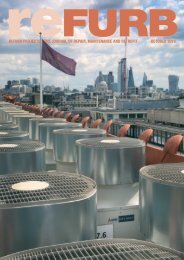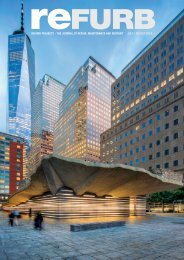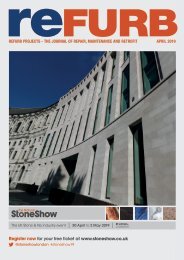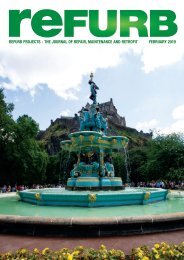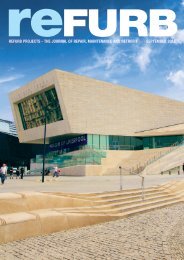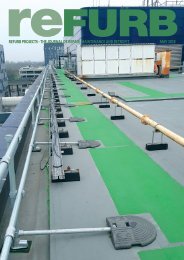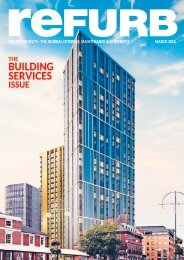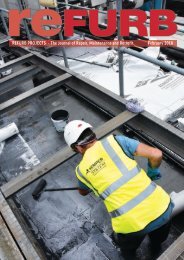Refurb Projects August 2017
Create successful ePaper yourself
Turn your PDF publications into a flip-book with our unique Google optimized e-Paper software.
SOCIAL HOUSING<br />
Wireless emergency lighting in social housing<br />
When refurbishing social housing developments, one of the highest priorities for building owners and specifiers<br />
alike is the safety of residents. So, when Peabody, one of the largest housing associations in the UK, had the<br />
opportunity to overhaul emergency lighting across its estate of over 17,000 blocks, it turned to Harvard<br />
Technology to provide an innovative lighting solution.<br />
With over 80,000<br />
residents occupying its<br />
extensive estate, the<br />
necessity for effective<br />
and efficient emergency lighting<br />
was fundamental to Peabody’s plans<br />
to revamp its housing blocks. Not<br />
only does the housing provider wish<br />
to protect occupants, they also have<br />
to obey increasing stringent<br />
emergency regulations, which<br />
include the requirement for monthly<br />
and yearly functional and duration<br />
tests compulsory under test<br />
standards. Non-compliance with<br />
such standards would result in<br />
potentially hefty fines and<br />
repercussions for the housing<br />
provider.<br />
The long-awaited revision to the<br />
Emergency Lighting Code of Practice<br />
BS5266:1 2016, issued in May 2016,<br />
has only compounded the necessity<br />
The EyeNut wireless lighting control system.<br />
for sufficient emergency lighting in<br />
social housing blocks and Peabody<br />
were keen to address the issue.<br />
Although the regulations have<br />
been widely accepted as a step in<br />
the right direction for emergency<br />
lighting, especially in large, densely<br />
populated housing blocks, they have<br />
also brought a new unique set of<br />
challenges for both social housing<br />
providers and specifiers. Keen to<br />
address the issue at hand and<br />
improve emergency lighting<br />
significantly, Peabody sought a<br />
solution that would ensure<br />
functional emergency lighting at all<br />
times, whilst also keeping<br />
maintenance and operational costs<br />
to a minimum.<br />
The company understood the<br />
importance of installing an LED<br />
lighting solution that offered<br />
greater efficiency, lower running<br />
costs, and perhaps<br />
most importantly,<br />
improved<br />
illumination when<br />
compared to the<br />
traditional<br />
incandescent<br />
lighting installed<br />
previously. Equally<br />
essential was having<br />
a scalable and<br />
controllable lighting<br />
portfolio across all<br />
its buildings in the<br />
future. With<br />
ambitions to employ<br />
enhanced control<br />
strategies across its<br />
estate including<br />
occupancy detection,<br />
daylight harvesting,<br />
scene setting and time scheduling,<br />
Peabody also needed a system<br />
capable of delivering advanced<br />
control options.<br />
SMART EMERGENCY LIGHTING<br />
Harvard Technology, and fixture<br />
designer and manufacturer Fern<br />
Howard, worked closely with<br />
Peabody and the refurbishment<br />
team to review the social housing<br />
blocks’ requirements and ensure the<br />
best technology fit for the facilities.<br />
The specified solution was an<br />
integrated LED lighting system with<br />
a wireless-enabled emergency<br />
bulkhead fixture, which could link<br />
with the innovative wireless lighting<br />
control system EyeNut.<br />
The system, initially installed in<br />
two housing blocks in phase one of<br />
the project, comprised 80 emergency<br />
bulkhead LED fixtures, with 70% of<br />
these fixtures including an<br />
innovative emergency feature,<br />
enabled through the EyeNut<br />
Combined Emergency driver. The<br />
entire lighting portfolio is controlled<br />
through EyeNut, an intuitive cloudbased,<br />
remote access, wireless<br />
control system for indoor and<br />
outdoor lighting.<br />
Needing to meet emergency<br />
lighting test standards, which<br />
necessitate both monthly and yearly<br />
tests for the full rated duration of<br />
the emergency lights, the retrofit<br />
high-performance driver provided<br />
the perfect solution. An automatic<br />
test feature incorporated within the<br />
driver ensures all tests can be<br />
completed remotely, eliminating the<br />
requirement for monthly site visits.<br />
Results of the automatically<br />
scheduled functional and duration<br />
testing are exported for audit<br />
tracking through the EyeNut Graphic<br />
User Interface (GUI). For Peabody,<br />
this not only ensured complete<br />
compliance with emergency lighting<br />
regulations, but also saved them<br />
substantial time and money on<br />
maintenance.<br />
Connecting thousands of fixtures<br />
across a complex housing estate<br />
using a wired lighting control<br />
solution would prove almost<br />
impossible for Peabody, but wireless<br />
lighting control solutions have<br />
changed that completely. Unlike<br />
wired systems, the cloud-based<br />
EyeNut system is infinitely scalable<br />
and there are no limits to the<br />
number of locations, the number of<br />
gateways, or even the number of<br />
devices, which can be managed<br />
through the central hub.<br />
Using EyeNut, up to 500 EyeNutenabled<br />
devices can be controlled<br />
from a single gateway, via a robust,<br />
secure, ZigBee wireless mesh<br />
network. Facilities Managers can<br />
even manage both indoor and<br />
outdoor lighting fixtures, in car<br />
parks for instance, using the same<br />
system.<br />
For Peabody, this provided untold<br />
advantages. Through the intuitive<br />
EyeNut system, the leading housing<br />
provider can monitor and manage<br />
their entire lighting portfolio with<br />
multi-site control from a single hub.<br />
Accurate real-time energy data,<br />
including kilowatt/hours’ usage and<br />
energy hot spots, is easily accessible<br />
through the system’s GUI allowing<br />
Peabody to implement energy<br />
efficiency strategies and make<br />
further savings. Crucially, from an<br />
emergency lighting standpoint,<br />
maintenance has also been<br />
dramatically improved across the<br />
Peabody estate as any lamp failures<br />
are reported immediately, enabling<br />
necessary repairs to be made.<br />
By installing an LED lighting solution<br />
and wireless lighting controls,<br />
Peabody achieved a marked<br />
reduction in energy consumption<br />
across its two blocks, with energy<br />
savings equating to 44%. Through<br />
enhanced dimming and sensor<br />
control throughout its estate, the<br />
leading housing association is<br />
aiming to reach 50% energy savings.<br />
For more information visit:<br />
www.harvardtechnology.com<br />
12 AUGUST <strong>2017</strong>, REFURBISHMENT PROJECTS







